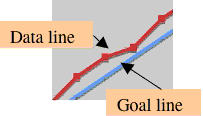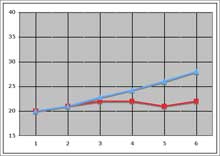How can Tier 3 intervention be implemented?
Page 5: Implementing Tier 3 Reading Interventions
 Once students have been identified as needing Tier 3 intervention, it is time to start delivering more intensive, individualized instruction. High quality instruction in Tier 3 covers the core components of reading (i.e., phonemic awareness, phonics and word study, reading comprehension, vocabulary, fluency) and should be research validated. Many research-validated reading interventions are based on key instructional principles:
Once students have been identified as needing Tier 3 intervention, it is time to start delivering more intensive, individualized instruction. High quality instruction in Tier 3 covers the core components of reading (i.e., phonemic awareness, phonics and word study, reading comprehension, vocabulary, fluency) and should be research validated. Many research-validated reading interventions are based on key instructional principles:
-
Systematic instruction is that which is carefully planned and sequenced so that its lessons build on one another, moving from simple skills and concepts to more complex ones.
-
Explicit or direct instruction involves teaching a specific skill or concept in a highly structured environment using clear, direct language. This type of instruction focuses on producing specific learning outcomes and is sometimes achieved through the use of scripted lessons. During explicit instruction, the teacher clearly identifies the expectations for learning, highlights important details of the concept or skill, provides precise instructions, and connects new learning to previous learned material.
-
Immediate corrective feedback is provided as soon as possible following the performance of an activity to inform the student that his or her answer is inaccurate and to correct his or her understanding of the skill or concept at issue.
-
Frequent review is the practice of revisiting a skill or concept over time to assess understanding and mastery and to ensure that the skill is maintained.
-
To help students to maintain their previously mastered skills, teachers should provide students with opportunities to practice them. In addition, immediately after a skill has been taught, teachers should offer students opportunities to practice it in order to build mastery. This can include guided as well as independent practice.
-
Scaffolded instruction is a process during which a teacher adds instructional supports to enhance a student’s learning and aid in the mastery of a skill, concept, or task.

Activity
After reviewing the definitions for the six key instructional principles listed above, watch the video clips below. For each video, select the instructional principle being highlighted.
Activity A
(Close this panel)
Activity B
(Close this panel)
Activity C
(Close this panel)
“Copyright © by the Texas Education Agency and University of Texas at Austin. All rights reserved” on all Licensed Materials.
A school or district can determine how effectively a program covers the five core components and utilizes key instructional principles.
Best Evidence Encyclopedia
http://www.bestevidence.org/
Center for Data-Driven Reform in Education (John Hopkins University)
This online clearinghouse offers information on the researched evaluations of numerous educational programs in a coherently arranged and easy-to-navigate format.
Big Ideas in Beginning Reading
http://reading.uoregon.edu/
Institute for the Development of Education Achievement, University of Oregon
This website focusing on the five core components of reading offers information and resources to educators and parents with the goal of ensuring that all students are able to read at grade-level by the close of their third-grade year.
The Florida Center for Reading Research
http://www.fcrr.org/
Florida State University Learning Systems Institute
This site exists to broadcast research-validated information regarding literacy and assessment. Included are articles related to RTI implementation and information for principals about how to improve reading outcomes in their schools.
What Works Clearinghouse
https://ies.ed.gov/ncee/wwc/
U.S. Department of Education
Browse this site to read the latest from the U.S. Department of Education on topics related to “Beginning Reading,” “English Learners,” and “Dropout Prevention.” Online resources allow users to create their own “Effectiveness Rating” chart.
For Your Information
Whereas the five core components of reading have been demonstrated to be effective for native English speakers, more research is needed to determine their effectiveness for English learners (ELs) with learning disabilities.
 Rosa Parks Elementary |
| Tier 3: special education |
| Amount of daily instruction: 45 minutes; 5 days per week |
| Frequency of progress monitoring: 2 times per week |
| Provider: special education teacher |
| Duration of instruction: based on individual student’s needs |
Every day, Laney receives 45 minutes of intensive, individualized instruction in Tier 3 in addition to 90 minutes of instruction in Tier 1. Ms. Jacobs, the special education teacher, provides the Tier 3 intervention. When Laney first begins Tier 3 intervention, Ms. Jacobs administers a brief reading assessment and determines that Laney has difficulty with decoding. Using this information, Ms. Jacobs begins working with Laney on letter-sound correspondence and sight words. After three weeks of collecting progress monitoring data (six data points — two probes per week for three weeks) from Laney, Ms. Jacobs evaluates these data using a method known as the four-point rule. She examines the relationship between the four most recent data points on Laney’s graph and goal line. She uses these data to determine whether Laney is making adequate progress toward the goals outlined in her individualized education program (IEP).
individualized education program (IEP)
An individualized education program (IEP) is a working document that specifies individualized learning goals, in addition to any accommodations, modifications, and related services the child may need to attend school and to maximize learning.
- If Laney is not making progress then Ms. Jacobs changes her instructional method.
- If Laney is responding to instruction, Ms. Jacobs continues with instruction.
- If Laney is surpassing her goal, Ms. Jacobs discusses her progress with the IEP team with an eye toward possibly increasing Laney’s goal.
| Above the goal line… | Below the goal line… | Around the goal line… |
| Increase the goal. If most of the points are higher than the goal line, the student’s performance is exceeding expectations and a slightly more ambitious goal is needed. | Change instruction. Something isn’t working. Try a different instructional approach and continue to collect data. | Make no changes. The method appears to be working. The student is on target to meet the year-end goal. |
 |
 |
 |
Because Laney’s last four data points are below the goal line, Ms. Jacobs changes her instruction. In addition to having her work on letter-sound correspondence and sight words, Ms. Jacobs asks Laney to write the words she is reading and begins using decodable books, as opposed to just word lists for reading practice. Two weeks later, Ms. Jacobs will again examine Laney’s data (four data points) to determine whether to continue or to change her instruction.

Laney graph: This graph shows Laney’s data point graph and goal line graph. The x-axis is labeled “1 through 6” in one-point intervals. The y-axis is labeled “15 through 40” in five-point intervals. Laney’s data points are in red and are as follows for weeks 1 through 6: 20, 22, 23, 23, 21, and 23. Laney’s goal line stretches from 20 at week 1 to 28 at week 6. Laney’s first three data points are around the goal line, but her last three data points fall below the goal line.
Listen as Doug and Lynn Fuchs discuss the characteristics that make special education unique and individualized.

Doug Fuchs, PhD
Nicholas Hobbs Endowed Chair
in Special Education and Human Development
Vanderbilt University, Nashville, TN
(time: 0:24)

Lynn Fuchs, PhD
Nicholas Hobbs Endowed Chair
in Special Education and Human Development
Vanderbilt University, Nashville, TN
(time: 0:19)
Transcript: Doug Fuchs, PhD
What should be “special” about special education is that it should be data-based, individualized, and recursive, meaning that the special education teacher uses an experimental approach to determine what effective instruction is for each kid. It is not going to be known up front what the right curriculum is for this kid, what the right instructional approach is for this kid.
Transcript: Lynn Fuchs, PhD
You have progress monitoring data, and you test the effectiveness of instructional components for a child. And you incorporate the ones that look effective for that child, and you drop other components that don’t look effective. So it’s experimental for that child.


